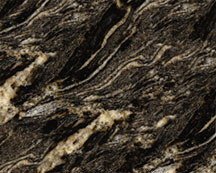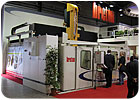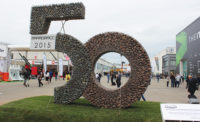
The 42nd edition of Marmomacc, the International Natural Stone and Technology Exhibition, took place from October 4 to 7, 2007, at VeronaFiere in Verona, Italy. And according to its show organizer, the increasingly international event confirmed its role as a landmark show in the natural stone industry by posting impressive attendance figures.
Those in attendance had the opportunity to view some of the largest exhibits of natural stone displays, machinery and accessories, and stone installation and maintenance products. Additionally, the show provided a forum for exhibitors and customers to meet new contacts and discuss business.
According to statistics, international visitors were up by 6% compared to last year, totaling almost 26,000 attendees from 110 countries, which set a record for the show, reported VeronaFiere. Overall, total attendance included 65,000 visitors, which was up 4% from 2006.
Additionally, the number of exhibitors this year totaled 1,510 from 50 countries, which was a 4% increase from the previous year. Approximately half of these exhibitors were international. The exhibit space spanned a net area in excess of 76,000 square meters (820,000 square feet), which was an increase of 5.5% from 2006.
Such impressive international attendance demonstrates the role now played by Marmomacc in regards to promotion of a sector that in Italy boasts more than 11,000 companies and 60,000 employees, with a turnover of more than 4 billion Euro (U.S. $5.8 billion), according to the show’s organizer.
The exhibition also welcomed approximately 30 international delegations - including major contingents from Brazil and Russia - as well as architects and designers from all over the world.
Following the settling stage in recent years - in the face of ever-stronger competition by emerging countries such as China and Turkey - the industry is showing significant signs of recovery, reports VeronaFiere. In the first half of 2007, on a national scale, Italy exported marble and granite blocks, slabs and finished products worth more than 903 million Euro (U.S. $1.3 billion) - a 2.8% increase against 878 million Euro (U.S. $1.28 billion) in the first half of 2006. In addition, Italy imported materials worth more than 309 million Euro (U.S. $447.6 million) for the first half of 2007, an increase of 2.4% over the same period in 2006.

The exhibition
For the first time, Verona welcomed exhibitors from Japan as well as Cyprus, Albania and Sierra Leone. As a result, Marmomacc now has representation from five continents as well as major trade show associations from Turkey, Argentina, Egypt, Morocco, Germany, Belgium, France, Brazil, Portugal, Croatia, Jordan, Iran, Spain, Pakistan, China and Taiwan.Another innovation this year, after the inauguration of halls 10 and 11 last year - totaling 20,000 square meters (215,000 square feet) dedicated to finished goods and design - is hall 7B, which covers 13,000 square meters (140,000 square feet). This is the largest hall ever dedicated to tools, abrasives and products for stone processing, according to VeronaFiere. This facility welcomes, in particular, institutional groups from Egypt and Spain with FDP (Spanish Natural Stone Federation). In addition to a display area of 1,500 square meters (16,000 square feet) that hosted more than 40 companies, the Spanish Association is working with VeronaFiere to promote the “New Stone Architecture in Spain” exhibition and other cultural shows.
This initiative illustrates new trends - through photos, projects and original designs - of the best works in stone completed over the last decade, including public buildings, offices, housing and urban projects by the leading protagonists of contemporary Spanish architecture - from Alberto Campo Baeza to Rafael Moneo.

Marmomacc Culture
The “Marble Architecture Design” program was also held as part of Marmomacc. This included the Biennial International Stone Architecture Awards, which are the top international awards for designers using stone materials, now celebrating its 10th edition (see “Marmomacc announces International Architecture in Stone Awards,” August 2007 Stone World, page 138). It also included a series of cultural initiatives focusing on the use of stone in contemporary architecture as well as acknowledging particular exhibitors who have worked together with design and interior design studios.This year, “Marmomacc Meets Design” launched the “Lightness of Marble” project, which involved internationally famous architects and designers such as Riccardo Blumer+Matteo Borghi, Aldo Cibic, Michele De Lucchi, Odile Decq, Kengo Kuma, Alberto Meda, Simone Micheli, Marco Piva, Denis Santachiara and Tobia Scarpa. Additionally, the project included exhibiting companies that lead the sector through the development of prototypes that will be presented on the stands of companies taking part in this initiative. (See “Marmomacc 2007: A Business and Design Success” for more information on the Marmomacc cultural events.)
Other events held during Marmomacc 2007 included “The Beauty of Marble” exhibition - organized in collaboration with the Women in Marble Association, which was founded in 2006 with the patronage of Marmomacc - the “Puglia Stone Landscape” exhibition and the “Best Communicator Award,” which was presented by a qualified jury to the best stand at the 42nd edition of the event.

The Brazilian presence
In addition to individual exhibitors from Brazil, the show floor also included a national Brazilian pavilion as well as one representing the State of Espírito Santo. Of particular note, Guilherme Dias, the Brazilian Minister for Planning and a leader in the South American stone field visited Marmomacc and met top VeronaFiere management.Accompanied by directors of Marmi Bruno Zanet Co. Verona, which opened its first production facility in Vitoria, the state capital, in 1982, the Minister illustrated investment opportunities in this district, where many production and commercial facilities are already operative, which can be attributed to the fact that 70% of the local population is of Italian origin, particularly from the Veneto region, reports VeronaFiere.
Dias explained that Espírito Santo “represents only 1% of the territory of Brazil,” but boasts “40% of granite quarries in the entire country, 60% of the national stone production and 70% of exports.”
“Parameters for the first half of 2007, indicate overall growth in exports: semi-finished goods are performing extremely well, offsetting a slight drop in unprocessed materials,” he said.
In terms of imports, Italy imported 41.17 million Euro (U.S. $59.75 million), worth of unprocessed stone from Brazil during the first half of 2007, compared to 49.75 million Euro (U.S. $72.2 million), during the same period a year earlier (a 17.2% drop). Imports of finished products came to 4.29 million Euro (U.S. $6.23 million), a slight (5.4%) drop against the 2007 figure of 4.54 million Euro (U.S. $6.59 million) during the same period last year.
Italian companies are fundamental in terms of development, and they have excellent operational prospects in the historic Cachoeiro district in southern Brazil and the emerging Vitoria district, due to its central geographical location and seaport, without forgetting the northern part of the Brazilian state, where new quarries have been opened in recent years, according to Dias. “Economic growth for Espírito Santo State, driven by the stone industry, is close to 10% per year, and it also benefits from the creation of Italian production centers and new financial instruments with incentives for investments,” he said.
Nevertheless, there are some concerns, especially in regard to globalization. “We have the same problems as Italy, beginning with the weak U.S. dollar, that affects our exports,” said the Minister. “While two years ago, one dollar was worth three real [Brazil’s currency], today the dollar is worth 1.8 real. Like everyone else, we are hit by competition from countries such as China and India, since our state is very small compared to these giants. Solutions? As I often hear said in Italy, we can also only continue to be competitive by promoting new infrastructures, technologies and closer cooperation relationships, which are being consolidated year after year, especially with Italy. In any case, the majority of the population has Italian origins and this helps develop contacts and business.”

Delegations and education
Institutional delegations visiting Marmomacc included the Walloons delegation Vallonia from Belgium, which was guided by Jean Claud Marour, Minister for International Business of the Belgian Region. Claudio Valente, Vice-President of VeronaFiere, welcomed the delegation to Marmomacc. This visit signified a strong commercial relationship between Italy and Belgium in the stone sector. Belgium, in accordance with Istat data for the first half of 2007 processed by the studies and research office of Verona Chamber of Commerce, took exports of finished products up by 19.9%, worth 10.4 million Euro (U.S. $15.09 million), against 8.68 million Euro (U.S. $12.6 million), during the same period in 1996.Additionally, Hon. Giulio Santagata, Minister for the Implementation of Government Programmes, also attended Marmomacc 2007 to discuss the economic situation in the stone industry. In the first half of 2007, the industry achieved exports of marble and granite, including blocks, slabs and finished products, which were worth more than 903 million Euro (U.S. $1.31 billion), compared to 878.54 million Euro (U.S. $1.28 billion), in the first half of 2006 (an increase of 2.8%), and imports totaling almost 310 million Euro (U.S. $449.9 million), compared to 302.63 million Euro (U.S. $439.21 million), in the same period (an increase of 2.4%).
Among other visitors to Marmomacc 2007 was a select group of architects comprised of members from the American Institute of Architects (AIA), an association representing more than 85,000 U.S. architects, the Royal Institute of British Architects (RIBA), the Royal Architectural Institute of Canada (RAIC) and also designers from South Africa, India and Australia. The group took part in a course titled “Designing With Natural Stone 2007.”
A delegation of Building Stone Institute members also visited Marmomacc, and they were hosted at a reception held at the Rock of Ages Corp. exhibition stand during the event. Another group organized by VeronaFiere and sponsored by the National Institute for International Trade (ICE) within the scope of the Italian Association of Exhibition Centres (AEFI) project, included a group of architects from the U.S. and Canada.
And finally, a third course, which was named “Dimensional Stone Materials, Technology and Design,” was coordinated by ICE-Assomarmomacchine-Isim, the International Marble Institute, and involved many architects from African countries.
Marmomacc also welcomed hundreds of buyers selected through the VeronaFiere international sales network - hailing from Brazil, Chile, Paraguay, Uruguay, Columbia, Switzerland, Austria, France, Great Britain, Hungary, Germany, Australia, South Africa, Texas, Canada, India, Egypt, Tunisia, Jordan and Israel. Buyers were given the opportunity to analyze online previews of presentation data cards detailing exhibitors, many of which were interested in arranging meetings. During the exhibition, such meetings were held at exhibitors’ stands or at the “Buyers Club” Area (Hall 7B), which also served as a meeting point and “business-to-business” area for all visitors qualified and accredited by the VeronaFiere International Service.



